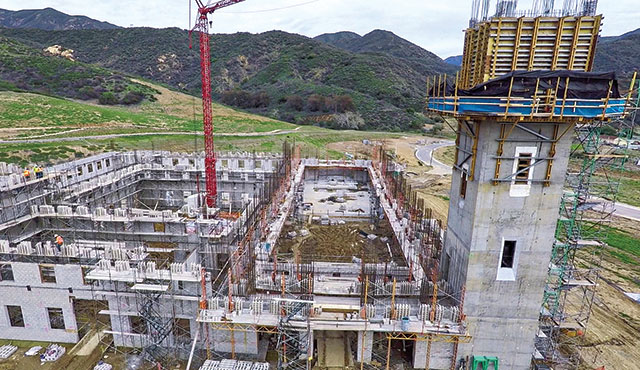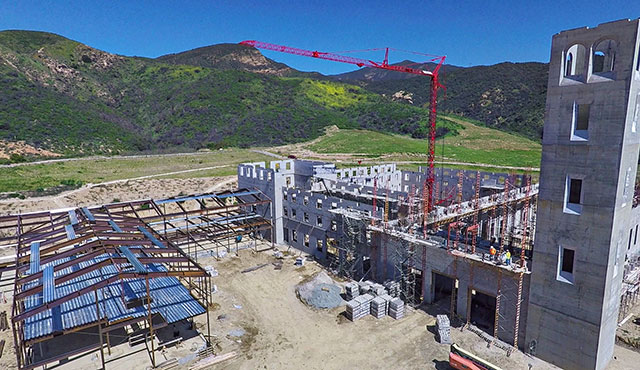On a rugged hillside in Silverado Canyon – where hawks circle overhead and the wind whistles through the branches of California live oak trees – workers are constructing a massive stone abbey.
Reminiscent of the great monasteries of Europe, the long, Romanesque-style church has a 100-foot bell tower that juts into the horizon and graceful rounded arches. In fall 2020, if all goes according to plan, the church will accommodate 500 people for Mass.
The Norbertine Fathers’ 55-acre St. Michael’s Abbey expansion is well underway.
“It’s very exciting to see a project that began in 2006, with strong fundraising efforts in 2015-16, finally coming to life,” says Father Justin Ramos, O. Praem., head of fundraising for the expansion project.
Matt Construction of Santa Fe Springs is building the project, which includes a monastery where the fathers and seminarians will live; a convent; an administration building with offices for Abbot Eugene Hayes, O. Praem. and his staff; and a large guest house. Included also are conference rooms, a cemetery, crypt, and cemetery chapel.
Matt Construction has worked on many prominent projects in Southern California and beyond, including the Petersen Automotive Museum, The Broad, and the Music Center Plaza. The project’s architect, Jean-Louis Pagès, was chosen more than a decade ago after his design of an abbey caught the eye of St. Michael’s leaders while they were touring southern France.
Construction began in July 2018 and completion of the expansion is expected in October 2020, Father Ramos said.
“We are blessed to have strong support from donors who are interested in what we do,” Father Ramos continues. Led by Gemini Industries Corp. founder and chairman Sebastian ‘Paul’ Musco and his wife Marybelle, generous benefactors both local and throughout North America have given $120 million to fund the expansion. Nearly 30 percent of the gifts for the new abbey came from outside the diocese.
The Norbertine Fathers first came to Orange County in 1961, Fr. Ramos says, when seven priests fleeing the Hungarian Revolution were invited by Cardinal James McIntyre to live and work in Orange County, which was then part of the Archdiocese of Los Angeles.
The men purchased their current Silverado Canyon property, located one block from Cook’s Corner, from Mr. Cook himself and built the boys’ boarding school, church, and residences. Today the Norbertines minister and teach in dozens of parishes and parish schools throughout the Diocese of Orange. They say Mass and provide ministry beyond the diocese as well, in Los Angeles, San Diego, Riverside and San Bernardino counties.
“We’ve outgrown this property,” he notes, adding that with more than 50 priests, 40 seminarians, and 64 students, the hillside complex cannot hold everyone who wants to live, work, and be educated there. At the 7 a.m. weekday Masses and 11 a.m. Sunday Mass – often attended by lay worshippers – parking can be difficult, especially so at Christmas and Easter.
The new abbey property is located several miles away and includes 327 acres on both sides of Silverado Canyon Road. Formerly part of the Holt Ranch, much of the Norbertines’ land will remain wilderness crisscrossed by hiking trails, Fr. Ramos says.
He recently returned from a visit to a little town in the French Alps where he blessed the caldron of molten bronze that was then poured into a mold to create the sixth and largest bell designated for the abbey bell tower. The two-ton bell, like the other five, has an inscription and portrait of a saint. In this case, the largest bell is named for Our Lady and features an image designed by a Norbertine seminarian.
Fr. Ramos believes that holy intervention is one reason the expansion property was made available to the Norbertine fathers. He describes a 2006 hike in Silverado Canyon during which he and some companion priests agreed that the property was desirable for the abbey expansion. The Norbertine fathers secretly erected a statue to St. Joseph on one of the hilltops and asked the saint to look favorably upon their possible purchase of the land. Their initial efforts failed, but six years later the fathers were able to buy the land, and they discovered that St. Joseph’s weather-worn statue remained on the hill where it remains to this day.
“For decades many lay faithful come to St. Michael’s Abbey to pray, attend the Liturgy of the Hours, and participate in Gregorian chants,” notes Fr. Damien Giap, a Norbertine Father who ministers in St. John the Baptist parish and school in Costa Mesa. “The new facilities will accommodate priests and seminarians and all those who want to come to us to pray. The new abbey will allow us to offer spiritual conferences and retreats, which we can’t do presently for lack of space.”
The breathtaking beauty of the canyon offers unparalleled views and a natural environment that will attract religious and lay visitors who want to enjoy quiet solitary walks through the hills, Fr. Giap adds.
“Like the magnificent churches in Italy, ultimately the abbey speaks to the love that the people have for God,” he says. “Building a beautiful church gives glory to God. While it is true that you can pray anywhere, churches don’t take away from Christ’s poor but instead give everyone a beautiful place to pray.”


